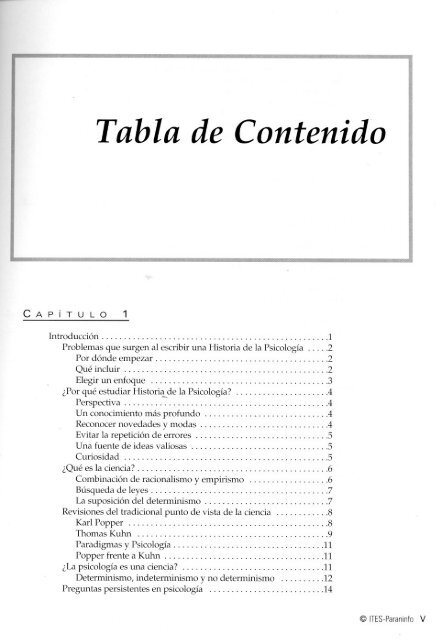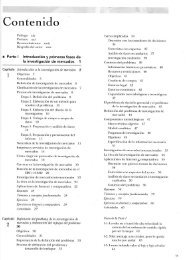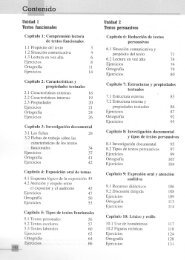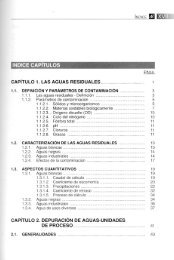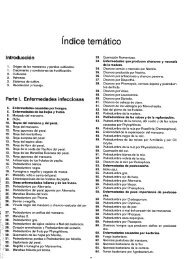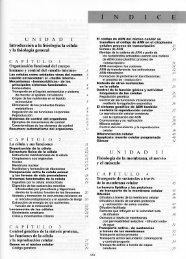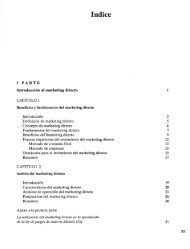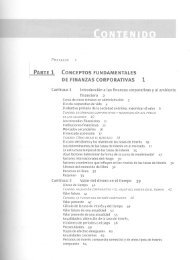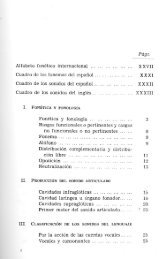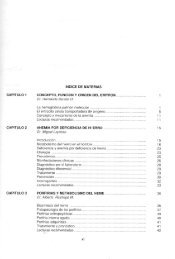Tabla de Contenido
Tabla de Contenido
Tabla de Contenido
You also want an ePaper? Increase the reach of your titles
YUMPU automatically turns print PDFs into web optimized ePapers that Google loves.
<strong>Tabla</strong> <strong>de</strong> <strong>Contenido</strong><br />
CAPíTULO 1<br />
Introducción 1<br />
Problemas que surgen al escribir una Historia <strong>de</strong> la Psicología. . . . .2<br />
Por dón<strong>de</strong> empezar 2<br />
Qué incluir 2<br />
Elegir un enfoque 3<br />
¿Por qué estudiar Historia <strong>de</strong> la Psicología 4<br />
Perspectiva ~ 4<br />
Un conocimiento más profundo , 4<br />
Reconocer noveda<strong>de</strong>s y modas 4<br />
Evitar la repetición <strong>de</strong> errores 5<br />
Una fuente <strong>de</strong> i<strong>de</strong>as valiosas 5<br />
Curiosidad 5<br />
¿Qué es la ciencia 6<br />
Combinación <strong>de</strong> racionalismo y empirismo 6<br />
Búsqueda<strong>de</strong>leyes 7<br />
Lasuposición<strong>de</strong>l<strong>de</strong>terminismo .7<br />
Revisiones <strong>de</strong>l tradicional punto <strong>de</strong> vista <strong>de</strong> la ciencia. . . . . . . . . . . .8<br />
KarlPopper 8<br />
ThomasKuhn 9<br />
ParadigmasyPsicología 11<br />
PopperfrenteaKuhn 11<br />
¿La psicología es una ciencia 11<br />
Determinismo, in<strong>de</strong>terminismo y no <strong>de</strong>terminismo .12<br />
Preguntas persistentes en psicología. . . . . . . . . . . . . . . . . . . . . . . . . .14<br />
@ ITES-Paraninfo V
VI<br />
TABLA DECONTENIDO<br />
¿Cuál es la naturaleza <strong>de</strong> la naturaleza humana . . . . . . . . . . . . .15<br />
¿Cómo están relacionados la mente y el cuerpo .15<br />
NativismofrenteaEmpirismo 17<br />
MecanicismofrenteaVitalismo 17<br />
Racionalismo frente a Irracionalismo . . . . . . . . . . . . . . . . . . . . . . .17<br />
¿Cómo están relacionados los hombres con los animales .18<br />
¿Cuál es el origen <strong>de</strong>l conocimiento humano .18<br />
Realidad objetiva frente a realidad subjetiva. . . . . . . . . . . . . . . . .19<br />
Elproblema<strong>de</strong>l'yo 19<br />
Resumen 20<br />
Preguntas para estudiar 22<br />
LecturasRecomendadas .23<br />
Glosario 24<br />
CAPíTULO 2<br />
Los antiguos filósofos griegos "" 29<br />
El mundo <strong>de</strong> los hombres precivilizados . . . . . . . . . . . . . . . . . . . . . . .29<br />
Animismoyantropomorfismo .29<br />
"Magia 30<br />
Religión <strong>de</strong> los antiguos griegos .30<br />
Losprimerosfilósofos .31<br />
Tales 31<br />
Anaximandro 32<br />
Herác1ito 32<br />
Parméni<strong>de</strong>s 33<br />
Pitágoras 34<br />
Empédoc1es 35<br />
Demócrito .37<br />
Medicina<strong>de</strong>losantiguosgriegos .38<br />
Alcmaeon 38<br />
Hipócrates ~ 38<br />
Relatividad <strong>de</strong> la verdad 40<br />
Protágoras 40<br />
Gorgias 41<br />
Jenófanes 41<br />
Sócrates 42<br />
Platón 43<br />
Teoría <strong>de</strong> las formas o <strong>de</strong> las i<strong>de</strong>as 43<br />
Analogía<strong>de</strong>lalíneadivisible .43<br />
Alegoría <strong>de</strong> la caverna 44<br />
Reminiscencias <strong>de</strong> la teoría <strong>de</strong>l conocimiento. . . . . . . . . . . . . . . .45<br />
Naturaleza <strong>de</strong>l alma 45<br />
Legado<strong>de</strong>Platón 46<br />
Aristóteles 46<br />
Diferencia básica entre Platón y Aristóteles . . . . . . . . . . . . . . . . . .47<br />
Causalidadyteleología 48<br />
Jerarquía<strong>de</strong>lasalmas 49<br />
@ ITES-Paraninfo
TABLA DE CONTENIDO VII<br />
Sensación 49<br />
Sentido común, razón pasiva y razón activa. . . . . . . . . . . . . . . . .50<br />
Memoria y recuerdo 51<br />
Imaginar y soñar 52<br />
Motivaciónyfelicidad 52<br />
Emociones y percepción selectiva. . . . . . . . . . . . . . . . . . . . . . . . . .53<br />
Importancia <strong>de</strong> la antigua filosofía griega.<br />
Resumen<br />
. . . . . . . . . . . . . . . . . . . . .54<br />
54<br />
Preguntas para estudiar<br />
LecturasRecomendadas<br />
57<br />
.59<br />
Glosario 60<br />
CAPíTULO 3<br />
Después <strong>de</strong> Aristóteles: en busca <strong>de</strong> una buena vida. . . . . . . . . . . . . . . .65<br />
Escepticismoycinismo 65<br />
Escepticismo 65<br />
Cinismo 66<br />
Epicureísmoyestoicismo .67<br />
Epicureísmo 67<br />
Estoicismo 69<br />
Neoplatonismo 70<br />
Filón 70<br />
Plotino 71<br />
Énfasis en el espíritu 72<br />
Jesús 73<br />
San Pablo 73<br />
SanAgustín 74<br />
La época oscura : 77<br />
La influencia árabe 78<br />
Avicena 79<br />
Averroes 80<br />
Reconciliación <strong>de</strong> la razón con la fe : .80<br />
SanAnselmo 80<br />
PeterLombard 81<br />
Escolasticismo 81<br />
Pedro Abelardo 81<br />
San Alberto Magno 83<br />
Santo Tomás <strong>de</strong> Aquino 83<br />
Limitaciones <strong>de</strong> la filosofía escolástica. . . . . . . . . . . . . . . . . . . . . .85<br />
Guillermo <strong>de</strong> Ockham: un cambio <strong>de</strong> razonamiento. . . . . . . . . . . .86<br />
Espíritu <strong>de</strong>l tiempo antes <strong>de</strong>l Renacimiento. . . . . . . . . . . . . . . . . . . .87<br />
Resumen 88<br />
Preguntas para estudiar 90<br />
Lecturas Recomendadas ... ... 91<br />
Glosario 93<br />
@ ITES-Paraninfo
VIII<br />
TABLADE CONTENIDO<br />
CAPíTULO 4<br />
Orígenes <strong>de</strong> la ciencia mo<strong>de</strong>rna y <strong>de</strong> la filosofía. . . . . . . . . . . . . . . . . . . .95<br />
Humanismorenacentista 95<br />
Generalida<strong>de</strong>s 95<br />
FranciscoPetrarca 96<br />
GiovanniPico 97<br />
Erasmo<strong>de</strong>Rotterdam 97<br />
MartínLutero 98<br />
Michel<strong>de</strong>Montaigne 99<br />
Más <strong>de</strong>safíos a la autoridad <strong>de</strong> la Iglesia. . . . . . . . . . . . . . . . . . . . . .100<br />
Tolomeo, Copémico, Kepler y Galileo<br />
ClaudioTolomeo<br />
. . . . . . . . . . . . . . . . . .101<br />
101<br />
NicolásCopémico 101<br />
JohannesKepler<br />
Galileo<br />
1O3<br />
103<br />
IsaacNewton 106<br />
Principios <strong>de</strong> la ciencia newtoniana --. . . . . . . . . . . .107<br />
FrancisBacon 108<br />
Lacienciabaconiana 109<br />
La ciencia <strong>de</strong>be proporcionar información útil.<br />
RenéDescartes<br />
. . . . . . . . . . . . .110<br />
111<br />
Búsqueda <strong>de</strong> la verdad filosófica <strong>de</strong> Descartes. . . . . . . . . . . . . .112<br />
I<strong>de</strong>asInnatas 113<br />
Elreflejo 114<br />
Explicación <strong>de</strong>l sueño y <strong>de</strong> los sueños <strong>de</strong> Descartes. . . . . . . . . .115<br />
Interacciónmente-cuerpo .115<br />
Contribución <strong>de</strong> Descartes a la psicología. . . . . . . . . . . . . . . . . .116<br />
Destino<strong>de</strong>Descartes 117<br />
Resumen 118<br />
Preguntas para estudiar<br />
LecturasRecomendadas<br />
120<br />
.121<br />
Glosario 123<br />
CAPíTULO 5<br />
Empirismo, sensacionalismo y positivismo. . . . . . . . . . . . . . . . . . . . . . .127<br />
Empirismobritánico<br />
ThomasHobbes<br />
128<br />
128<br />
JohnLocke 131<br />
GeorgeBerkeley<br />
DavidHume<br />
137<br />
141<br />
DavidHartley 148<br />
JamesMill 150<br />
JohnStuartMill<br />
Alexan<strong>de</strong>rBain<br />
153<br />
157<br />
Sensacionalismo francés 160<br />
PierreGassendi 160<br />
@ ITES-Paraninfo
TABLADECONTENIDOIX<br />
Julien<strong>de</strong>LaMettrie 161<br />
ÉtienneBonnot<strong>de</strong>Condillac ' 164<br />
Clau<strong>de</strong>Helvétius 165<br />
Positivismo 166<br />
AugusteComte 166<br />
Otrotipo<strong>de</strong>positivismo<br />
Resumen<br />
169<br />
169<br />
Preguntas para estudiar<br />
LecturasRecomendadas. ...<br />
172<br />
... .174<br />
Glosario 176<br />
CAPíTULO 6<br />
Racionalismo 181<br />
BaruchSpinoza<br />
Naturaleza <strong>de</strong> Dios<br />
182<br />
183<br />
Relación mente-cuerpo 183<br />
Negación <strong>de</strong>l libre albedrío 184<br />
Autoproteccióncomo motivo principal .184<br />
Emociones y pasiones 185<br />
Influencia<strong>de</strong>Spinoza<br />
Nicolás <strong>de</strong> Malebranche<br />
185<br />
186<br />
GottfriedWilhelrnvonLeibniz 186<br />
DiscrepanciaconLocke 187<br />
Monadología 188<br />
Relación mente-cuerpo 188<br />
Percepción consciente e inconsciente.<br />
ThomasReid<br />
. . . . . . . . . . . . . . . . . . . . .189<br />
190<br />
Sentidocomún 191<br />
Realismodirecto 191<br />
Psicología<strong>de</strong> lasfaculta<strong>de</strong>s -: 192<br />
IrnmanuelKant 193<br />
Categorías<strong>de</strong>lpensamiento ... .194<br />
Causas<strong>de</strong>laexperienciamental 194<br />
Imperativo categórico<br />
Influencia <strong>de</strong> Kant<br />
196<br />
196<br />
Johann Friedrich Herbart 197<br />
La psicología como ciencia<br />
Mecánicafísica<br />
...197<br />
197<br />
Masaaperceptiva 198<br />
Psicología educacional<br />
Influencia<strong>de</strong>Herbart<br />
198<br />
199<br />
GeorgWilhelmFriedrichHegel<br />
Loabsoluto<br />
199<br />
199<br />
Proceso dialéctico 200<br />
Influencia<strong>de</strong>Hegel<br />
Resumen<br />
201<br />
201<br />
@ ITES-Paraninfo
X<br />
TABLA DECONTENIDO<br />
Preguntas para estudiar 204<br />
LecturasRecomendadas .205<br />
Glosario 207<br />
CAPíTULO 7<br />
Romanticismoyexistencialismo .211<br />
Romanticismo 211<br />
Jean-JacquesRousseau 212<br />
JohannWolfgangvonGoethe 215<br />
ArthurSchopenhauer 217<br />
FriedrichWillhelmNietzsche 219<br />
Existencialismo 224<br />
SorenKierkegaard 225<br />
KierkegaardyNietzsche : 228<br />
Resumen 228<br />
Preguntas para estudiar r-: 231<br />
Lecturas Recomendadas ..232<br />
Glosario 233<br />
CAPíTULO 8<br />
..<br />
Fisiología y psicología experimental. . . . . . . . . . . . . . . . . . . . . . . . . . . . .235<br />
Diferenciasindividuales 235<br />
Discrepancia entre la realidad objetiva y la realidad subjetiva. . . .236<br />
Ley <strong>de</strong> Bell-Magendie 237<br />
Doctrina sobre energías nerviosas específicas. . . . . . . . . . . . . . . . . .238<br />
JohannesMüller 238<br />
Hermann von Helrnholtz 240<br />
Helrnholtz contra elvitalismo 240<br />
Principio <strong>de</strong> conservación <strong>de</strong> la energía. . . . . . . . . . . . . . . . . . . .241<br />
Velocidad <strong>de</strong> la conducción nerviosa. . . . . . . . . . . . . . . . . . . . . .241<br />
Teoría<strong>de</strong>lapercepción .242<br />
Teoría<strong>de</strong>lavisión<strong>de</strong>loscolores 243<br />
Teoría <strong>de</strong> la percepción auditiva . . . . . . . . . . . . . . . . . . . . . . . . . .244<br />
Teoría<strong>de</strong>lossignos 245<br />
Contribuciones <strong>de</strong> Helrnholtz 246<br />
EwaldHering 246<br />
Percepción<strong>de</strong>lespacio 247<br />
Teoría<strong>de</strong>lavisión<strong>de</strong>lcolor ..247<br />
ChristineLadd-Franklin ..248<br />
Primeras investigaciones sobre el funcionamiento <strong>de</strong>l cerebro. . . .249<br />
Frenología 249<br />
PierreFlourens 252<br />
PaulBroca 253<br />
Gustav Fritsch, Edward Hitzig y David Ferrier .254<br />
El nacimiento <strong>de</strong> la psicología experimental. . . . . . . . . . . . . . . . . . .255<br />
@ ITES-Paraninfo
TABLADECONTENIDOXI<br />
ErnstHeimichWeber 255<br />
GustavTheodorFechner 257<br />
Resumen 262<br />
Preguntas para estudiar 265<br />
LecturasRecomendadas. .266<br />
Glosario 267<br />
CAPíTULO 9<br />
Priméras aproximaciones a la psicología. . . . . . . . . . . . . . . . . . . . . . . . .271<br />
Voluntarismo 272<br />
WilhelmMaximilianWundt 273<br />
Objetivos <strong>de</strong> la psicología .275<br />
Estudio<strong>de</strong>laIntrospección 275"<br />
Elementos<strong>de</strong>lpensamiento .276<br />
Percepción, apercepción y síntesis creativa . . . . . . . . . . . .276<br />
Cronometríamental 277<br />
Causalidad psicológica versus causalidad física. . . . . . . . . . . . .279<br />
Volkerpsychologie (Psicología <strong>de</strong> grupo o cultural) . . . . . . . . . .280<br />
Malentendido histórico <strong>de</strong> Wundt .280<br />
EdwardBradford Titchener .281<br />
Objetivos <strong>de</strong> la psicología .283<br />
Empleo<strong>de</strong>laintrospección .283<br />
Elementosmentales 284<br />
Ley <strong>de</strong> combinación 284<br />
Correlaciones neurológicas <strong>de</strong> los sucesos mentales. . . . . . . . .285<br />
Teoría <strong>de</strong>l contexto <strong>de</strong>l significado. . . . . . . . . . . . . . . . . . . . . . . .285<br />
Fin<strong>de</strong>lestructuralismo .285<br />
Otras primeras aproximaciones a la psicología. . . . . . . . . . . . . . . . .287<br />
HermannEbbinghaus ... ...287<br />
FranzClemensBrentano": .288<br />
CarlStumpf 290<br />
EdmundHusserl : 291<br />
OswaldKülpe 292<br />
HansVaihinger 294<br />
Resumen 295<br />
Preguntas para estudiar 298<br />
LecturasRecomendadas... 299<br />
Glosario 301<br />
CAPíTULO 10<br />
Influencia<strong>de</strong>Oarwin 305<br />
Teorías <strong>de</strong> la evolución anteriores a Oarwin . . . . . . . . . . . . . . . . . . .305<br />
JeanLamarck 306<br />
HerbertSpencer 306<br />
CharlesOarwin 309<br />
@ ITES-Paraninfo
XII TABLADECONTENIDO<br />
Elviaje<strong>de</strong>lBeagle 310<br />
De nuevo en Inglaterra 310<br />
Teoría <strong>de</strong> la evolución <strong>de</strong> Darwin .311<br />
Influencia<strong>de</strong>Darwin 312<br />
SirFrancisGalton 313<br />
Medida <strong>de</strong> la inteligencia 314<br />
Test<strong>de</strong>asociación<strong>de</strong>palabras .316<br />
Imagineríamental 316<br />
Antropometría .' 316<br />
Concepto <strong>de</strong> correlación .317<br />
Contribuciones <strong>de</strong> Galton a la psicología. . . . . . . . . . . . . . . . . . .318<br />
Test <strong>de</strong> inteligencia <strong>de</strong>spués <strong>de</strong> Galton .318<br />
JamesMcKeenCattell 318<br />
AlfredBinet 320<br />
Charles Spearman y el concepto <strong>de</strong> inteligencia general. . . . .325<br />
Escala <strong>de</strong> Binet Simon en los Estados Unidos. . . . . . . . . . . . . . . . . .325<br />
HenryHerbertGoddard 325<br />
LewisMadisonTerman : 328<br />
LetaStetterHollingworth 331<br />
Tests <strong>de</strong> inteligencia en el ejército 333<br />
RobertM.Yerkes 333<br />
Deterioro <strong>de</strong> la inteligencia nacional. . . . . . . . . . . . . . . . . . . . . . . . .335<br />
Resumen 336<br />
Preguntas para estudiar 340<br />
LecturasRecomendadas .342<br />
Glosario 345<br />
CAPíTULO 1 1<br />
Funcionalismo 349<br />
Inicios <strong>de</strong> la psicología en los Estados Unidos. . . . . . . . . . . . . . . . .349<br />
Fase uno: Filosofía moral y mental (1640-1776).. . . . . . . . . . . . .350<br />
Fase dos: Filosofía intelectual (1776-1886) """""""'" .350<br />
Fase tres: Renacimiento <strong>de</strong> los Estados Unidos (1886-1896) .. .350<br />
Fase cuatro: Funcionalismo <strong>de</strong> los<br />
Estados Unidos (1896al presente) . . . . . . . . . . . . . . . . . . . . . .351<br />
Características <strong>de</strong> la psicología funcionalista . . . . . . . . . . . . . . . . . . .351<br />
WilliamJames 352<br />
Lacrisis<strong>de</strong>James 353<br />
Oposición al enfoque <strong>de</strong> la psicología <strong>de</strong> Wundt . . . . . . . . . . . .355<br />
Corriente<strong>de</strong>conciencia 355<br />
Hábitoseinstintos .356<br />
Elyo 358<br />
Emociones 359<br />
Librealbedrío .360<br />
Pragmatismo 360<br />
Contribuciones <strong>de</strong> James a la psicología. . . . . . . . . . . . . . . . . . .361<br />
HugoMünsterberg 362<br />
@ ITES-Paraninfo
TABLA DE CONTENIDO XIII<br />
Psicología aplicada <strong>de</strong> Münsterberg . . . . . . . . . . . . . . . . . . . . . . .363<br />
Destino<strong>de</strong>Münsterberg .364<br />
MaryWhitonCalkins 365<br />
GranvilleStanleyHall .367<br />
Rector <strong>de</strong> la Universidad Clark 368<br />
Teoría<strong>de</strong>larecapitulación .369<br />
Psicología en la Universidad Clark . . . . . . . . . . . . . . . . . . . . . . . .370<br />
Funcionalismo en la Universidad <strong>de</strong> Chicago . . . . . . . . . . . . . . . . . .371<br />
JohnDewey 371<br />
JamesRowlandAngell 373<br />
HarveyCarr 374<br />
Funcionalismo en la Universidad <strong>de</strong> Columbia. . . . . . . . . . . . . . . .375<br />
JamesMcKeenCattell .375<br />
RobertSessionsWoodworth .376<br />
EdwardLeeThomdike .377<br />
Destino<strong>de</strong>lfuncionalismo 383<br />
Resumen 383<br />
Preguntas para estudiar 386<br />
LecturasRecomendadas .388<br />
Glosario 389<br />
CAPíTULO 12<br />
Conductismo 393<br />
Antece<strong>de</strong>ntes<strong>de</strong>lconductismo .393<br />
Psicologíaobjetivarusa 394<br />
IvánM.Sechenov 394<br />
IvánPetrovitchPavlov 396<br />
VladimirM.Bechterev 402<br />
JohnB. WatsonyelConductismo .404<br />
Psicología objetiva <strong>de</strong>Wat::mn 410<br />
Influencia<strong>de</strong>Watson 417<br />
William McDougall: otro tipo <strong>de</strong> conductismo . . . . . . :. . . . . . . . . .418<br />
Definición <strong>de</strong> psicología <strong>de</strong> McDougall . . . . . . . . . . . . . . . . . . . .419<br />
Conductaintencionada .420<br />
Importancia<strong>de</strong>losinstintos .420<br />
Batalla <strong>de</strong>l conductismo 421<br />
Resumen 423<br />
Preguntas para estudiar 426<br />
Lecturas Recomendadas ... .427<br />
Glosario 428<br />
CAPíTULO 13<br />
Neoconductismo 431<br />
Positivismo 431<br />
Positivismo lógico 432<br />
@ ITES-Paraninfo
XIV<br />
TABLADECONTENIDO<br />
Operacionismo 432<br />
Fisicalismo 433<br />
Neoconductismo 433<br />
EdwardChaceTolman ...434<br />
Conductismointencionado 436<br />
Empleo<strong>de</strong>ratas 437<br />
Utilizar las variables intervinientes . . . . . . . . . . . . . . . . . . . . . . . .437<br />
Postura <strong>de</strong> Tolman sobre el refuerzo. . . . . . . . . . . . . . . . . . . . . .438<br />
Aprendizaje versus ejecución 439<br />
Influencia<strong>de</strong>Tolman 440<br />
ClarkLeonardHull 441<br />
Teoría hipotético-<strong>de</strong>ductiva <strong>de</strong> Hull . . . . . . . . . . . . . . . . . . . . . . .443<br />
Influencia<strong>de</strong>Hull 444<br />
Burrhus Fre<strong>de</strong>ric Skinner 445<br />
Positivismo <strong>de</strong> Skinner 447<br />
Análisis funcional <strong>de</strong> la conducta. . . . . . . . . . . . . . . . . . . . . . . . .448<br />
Conducta operante ~ 449<br />
Naturaleza <strong>de</strong>l refuerzo 450<br />
Importancia<strong>de</strong>lentomo .450<br />
Control positivo <strong>de</strong> la conducta. . . . . . . . . . . . . . . . . . . . . . . ,'. .451<br />
Actitud <strong>de</strong> Skinner sobre la teoría. . . . . . . . . . . . . . . . . . . . . . . . .451<br />
Aplicaciones <strong>de</strong> los principios <strong>de</strong> Skinner . . . . . . . . . . . . . . . . . .452<br />
Un tributo a Skinner 453<br />
Elconductismohoy 454<br />
Resumen 455<br />
Preguntas para estudiar 457<br />
LecturasRecomendadas .458<br />
Glosario 459<br />
CAPíTULO 14<br />
Psicología <strong>de</strong> la Gestalt 461<br />
Antece<strong>de</strong>ntes <strong>de</strong> la psicología <strong>de</strong> la Gestalt . . . . . . . . . . . . . . . . . . . .462<br />
ImrnanuelKant 462<br />
EmstMach 462<br />
ChristianvonEhrenfels 462<br />
WilliamJames 463<br />
Psicología<strong>de</strong>losactos 463<br />
Desarrollosenfísica 463<br />
Fundación <strong>de</strong> la psicología <strong>de</strong> la Gestalt .463<br />
MaxWertheimer 464<br />
KurtKoffka 465<br />
WolfgangK6hler 466<br />
IsomorfismoylaLey<strong>de</strong>Pragnanz 468<br />
Aplicación <strong>de</strong> la teoría <strong>de</strong> campos. . . . . . . . . . . . . . . . . . . . . . . .469<br />
Isomorfismopsicofísico 469<br />
Oposición a la hipótesis <strong>de</strong> la constancia. . . . . . . . . . . . . . . . . . .469<br />
Análisis: <strong>de</strong>s<strong>de</strong> arriba hacia abajo,no <strong>de</strong>s<strong>de</strong> abajohacia arriba 470<br />
@ ITES-Paraninfo
TABLA DE CONTENIDO )0.J<br />
Ley<strong>de</strong>Pragnanz 471<br />
Constanciaperceptiva 471<br />
Gestaltenperceptiva 473<br />
Relación figura-fondo 473<br />
Realidad subjetiva y realidad objetiva. . . . . . . . . . . . . . . . . . . . . . . .474<br />
Explicación <strong>de</strong> la Gestalt sobre el aprendizaje. . . . . . . . . . . . . . . . . .475<br />
Tanteocognitivo 475<br />
Aprendizajepenetrante 475<br />
Transposición 477<br />
Explicación conductista <strong>de</strong> la transposición. . . . . . . . . . . . . . . .478<br />
Pensamiento productivo 479<br />
Memoria 480<br />
Procesos <strong>de</strong> memoria, trazas y sistemas. . . . . . . . . . . . . . . . . . . .480<br />
Teoría<strong>de</strong>loscampos<strong>de</strong>Lewin .481<br />
Concepto aristotélico <strong>de</strong> la ciencia frente al concepto galileano 481<br />
Espacio<strong>de</strong>vida 482<br />
Motivación 483<br />
Conflicto 484<br />
Dinámica <strong>de</strong> grupo 484<br />
Impacto <strong>de</strong> la psicología <strong>de</strong> la Gestalt .485<br />
Resumen 486<br />
Preguntas para estudiar 488<br />
Lecturas Recomendadas 489<br />
Glosario 491<br />
CAPíTULO 15<br />
Primeros diagnósticos, explicaciones y tratamientos <strong>de</strong> la<br />
enfermedad mental ..495<br />
¿Qué es la enfermedad mental 495<br />
Conducta dañina : 496<br />
Pensamientos y percepciones irreales . . . . . . . . . . . . . . . . . . . . . .496<br />
Emocionesinapropiadas : 496<br />
Conducta impre<strong>de</strong>cible 496<br />
Primeras explicaciones sobre la enfermedad mental. . . . . . . . . . . .497<br />
Explicaciones biológicas 497<br />
Explicacionespsicológicas 497<br />
Explicaciones sobrenaturales. . . . . . . . . . . . . . . . . . . . . . . . . . . . .497<br />
Primeros enfoques <strong>de</strong>l tratamiento <strong>de</strong> la enfermedad mental. . . .498<br />
Enfoquepsicológico 498<br />
Enfoquesobrenatural 499<br />
Enfoquebiológico 500<br />
El retorno al enfoque sobrenatural. . . . . . . . . . . . . . . . . . . . . . . .502<br />
Mejora gradual en el tratamiento <strong>de</strong> la enfermedad mental. . . . . .505<br />
PhilippePinel 506<br />
BenjaminRush 507<br />
DorotheaLyn<strong>de</strong>Dix 508<br />
EmiIKraepelin 509<br />
@ ITES-Paraninfo
XVI<br />
TABLADECONTENIDO<br />
LightnerWihner 510<br />
Tensión entre los mo<strong>de</strong>los psicológicos y médicos<br />
<strong>de</strong>laenfermedadmental 512<br />
Empleo<strong>de</strong>lhipnotismo<br />
FranzAntonMesmer<br />
513<br />
513<br />
Marqués<strong>de</strong>Puységur 515<br />
John Elliotson,James Esdaile y James Braid .515<br />
Escuela<strong>de</strong>Nancy 516<br />
Explicación propuesta por Charcot para la<br />
hipnosisylahisteria<br />
Resumen<br />
516<br />
519<br />
Preguntas para estudiar<br />
LecturasRecomendadas<br />
521<br />
.522<br />
Glosario 524<br />
CAPíTULO 16<br />
El psicoanálisis y sus primeras alternativas. . . . . . . . . . . . . . . . . . . . . . .527<br />
Antece<strong>de</strong>ntes <strong>de</strong>l <strong>de</strong>sarrollo <strong>de</strong>l psicoanálisis. . . . . . . . . . . . . . . . . .528<br />
SigmundFreud 530<br />
El episodio <strong>de</strong> la cocaína 531<br />
Primeras influencias en el <strong>de</strong>sarrollo <strong>de</strong>l psicoanálisis. . . . . . . . . . .532<br />
JosephBreueryelcaso<strong>de</strong>AnnaO.<br />
Visita<strong>de</strong>FreudaCharcot<br />
.532<br />
...535<br />
Nacimiento <strong>de</strong> la asociación libre. . . . . . . . . . . . . . . . . . . . . . . . .536<br />
Estudios sobre la histeria 536<br />
Proyecto <strong>de</strong> psicología científica. . . . . . . . . . . . . . . . . . . . . . . . . .537<br />
Teoría <strong>de</strong> la seducción 537<br />
Autoanálisis<strong>de</strong>Freud 540<br />
Análisis<strong>de</strong>lossueños ... ,.. 540<br />
Complejo<strong>de</strong>Edipo 541<br />
Psicopatología en la vida cotidiana. . . . . . . . . . . . . . . . . . . . . . . . . . .543<br />
El viaje <strong>de</strong> Freud a los Estados Unidos. . . . . . . . . . . . . . . . . . . . . . .544<br />
Revisión <strong>de</strong> los componentes básicos <strong>de</strong> la teoría <strong>de</strong> la<br />
personalidad<strong>de</strong>Freud 545<br />
Elid,elegoyelsuperego 545<br />
Ansiedad y los mecanismos <strong>de</strong> <strong>de</strong>fensa <strong>de</strong>l ego. . . . . . . . . . . . .547<br />
Fases <strong>de</strong>l <strong>de</strong>sarrollo psicosexual , .548<br />
Consi<strong>de</strong>raciones <strong>de</strong> Freud sobre la naturaleza humana. . . . . . . . .550<br />
El <strong>de</strong>stino <strong>de</strong> Freud 552<br />
Revisiones <strong>de</strong> la leyenda freudiana .552<br />
Realidad <strong>de</strong> las memorias reprimidas.<br />
Evaluación <strong>de</strong> la teoría<strong>de</strong>Freud<br />
. . . . . . . . . . . . . . . . . . . .553<br />
.557<br />
Críticas 557<br />
Contribuciones 558<br />
Contribuciones <strong>de</strong> Anna Freud al psicoanálisis. . . . . . . . . . . . . . . .559<br />
Primeras alternativas al psicoanálisis. . . . . . . . . . . . . . . . . . . . . . . . .562<br />
CarlJung 562<br />
@ ITES-Paraninfo
TABLADECONTENIDOXVII<br />
AlfredAdler 566<br />
KarenHorney 568<br />
Resumen 572<br />
Preguntas para estudiar 576<br />
Lecturas Recomendadas .578<br />
Glosario 580<br />
CAPíTULO 17<br />
Psicologíahumanística (tercera-fuerza) .585<br />
Lamente,elcuerpoyelespíritu .585<br />
Antece<strong>de</strong>ntes <strong>de</strong> la tercera-fuerza <strong>de</strong> la psicología. . . . . . . . . . . . . .586<br />
Fenomenología 587<br />
Psicologíaexistencial 588<br />
MartinHei<strong>de</strong>gger 588<br />
LudwigBinswanger 590<br />
RolloMay 592<br />
GeorgeKelly 595<br />
Psicologíahumanística<br />
AbrahamMaslow<br />
599<br />
599<br />
CarlRogers 605<br />
Comparación entre la psicología existencial y humanística<br />
Evaluación<br />
.609<br />
610<br />
Críticas 610<br />
Contribuciones 611<br />
Resumen 612<br />
Preguntas para estudiar<br />
Lecturas Recomendadas<br />
615<br />
...616<br />
Glosario 618<br />
CAPíTULO 18<br />
Psicología contemporánea 623<br />
Diversidad <strong>de</strong> la psicología contemporánea. . . . . . . . . . . . . . . . . . .623<br />
Divisiones <strong>de</strong> la Asociación Americana <strong>de</strong> Psicología (AP A) . .624<br />
Tensión entre psicología pura, científica y aplicada. . . . . . . . . . . . .624<br />
Controversia sobre la formación <strong>de</strong> los psicólogos clínicos. . . .629<br />
Dos culturas <strong>de</strong> la psicología 631<br />
Psicologíacognitiva<br />
Desarrollos anteriores a 1950<br />
, 632<br />
633<br />
Desarrollosdurantelosaños50 .634<br />
Desarrollos posteriores a los años 50 .635<br />
Inteligenciaartificial 637<br />
Psicología <strong>de</strong>l procesamiento <strong>de</strong> la información. . . . . . . . . . . . .640<br />
Psicobiología 643<br />
KarlS.Lashley 643<br />
DonaldO.Hebb 644<br />
@ ITES-Paraninfo
XVIII<br />
TABLA DECONTENIDO<br />
RogerW.Sperry<br />
Nuevoconexionismo<br />
646<br />
648<br />
Genéticaconductual 652<br />
Etología 652<br />
Sociobiología 653<br />
Influencia<strong>de</strong>NoamChomsky .654<br />
Mala conducta <strong>de</strong> los organismos. . . . . . . . . . . . . . . . . . . . . . . . .654<br />
Influencias genéticas en la inteligencia y en la personalidad. .655<br />
Estatus <strong>de</strong> la psicología como ciencia. . . . . . . . . . . . . . . . . . . . . . . . .657<br />
¿Existe algo nuevo en psicología<br />
Resumen<br />
.659<br />
661<br />
Preguntas para estudiar<br />
LecturasRecomendadas<br />
665<br />
.667<br />
Glosario 669<br />
ApÉNDICE<br />
A<br />
Personas y hechos significativos en la historia <strong>de</strong> la psicología. . . . . .673<br />
ApÉNDICE<br />
B<br />
Créditos 685<br />
Índice Alfabético 689<br />
",-,<br />
@ ITES-Paraninfo


